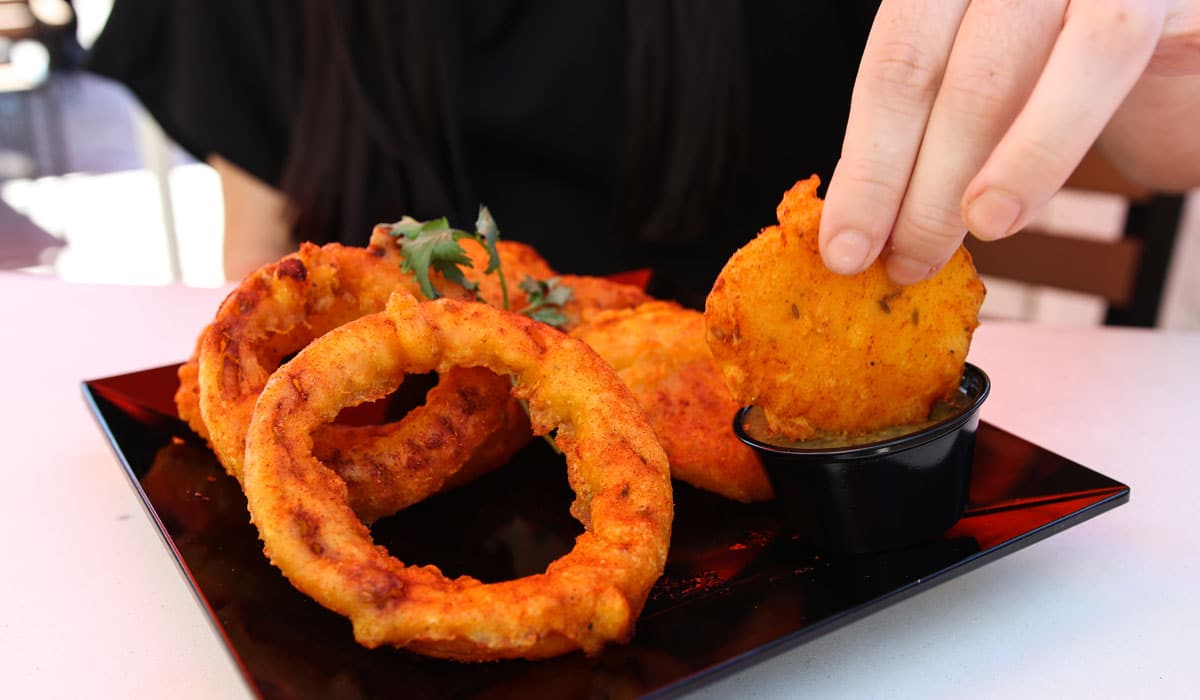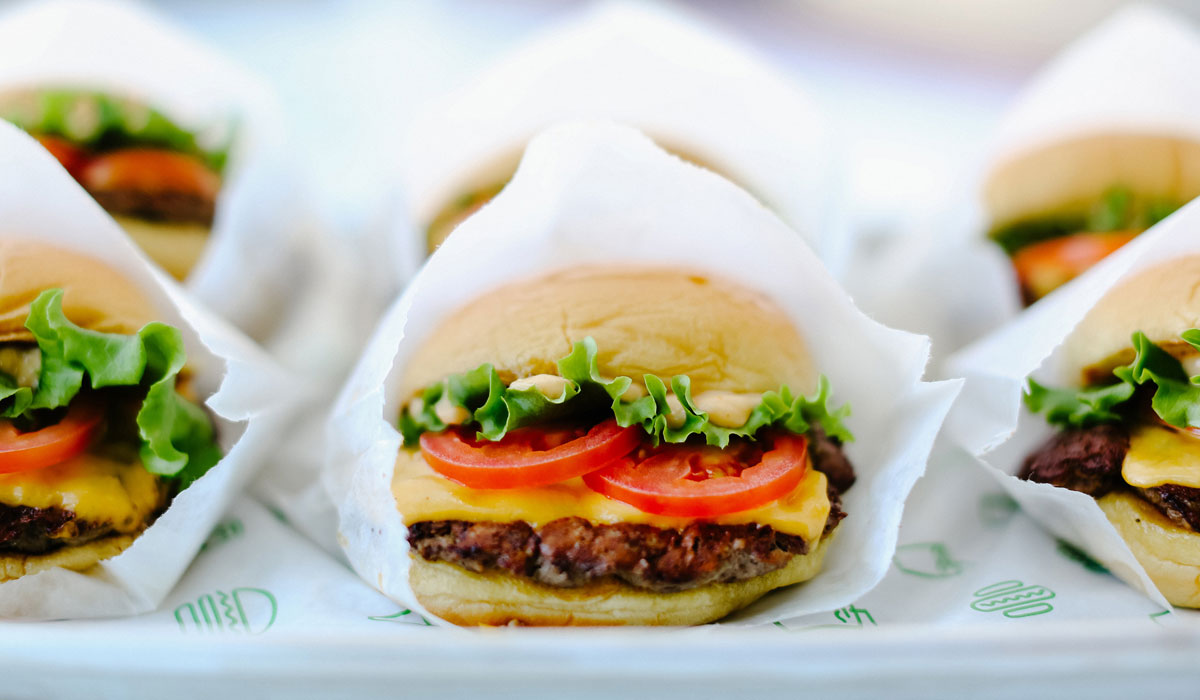No one, not even the world’s foremost health officials, is 100 percent sure when the COVID-19 pandemic will end.
Shake Shack CEO Randy Garutti, for one, is done trying to guess. Roughly 75 percent of stores have some form of limited dining open right now, and Garutti wishes more could be available—it’s good for business, especially in warmer weather. The hope is that as vaccinations increase, dining will return to normal sometime in the coming months.
But COVID is a fickle beast. So is mother nature. Shack Shack’s same-store sales improved to a decrease of 5 percent in January, and suburban stores even grew 8 percent. However, with the arrival of cold weather and snowstorms in February, 134 operating days were impacted by full and partial closures. Comps dropped to negative 16 percent through February 17 while suburban markets reverted to negative 4 percent. In the same period, urban markets went from a 17 percent decline to a 27 percent drop.
Here’s a breakdown of how same-store sales progressed across suburban and urban markets:

And here’s information on how comps are moving geographically:

The data trends only reemphasize the future unknown when it comes to dining rooms returning to full strength. It also expresses the need to further enhance digital tools, an area in which Shake Shack has invested heavily.
“Across all our Shacks, we’re working hard at a level of convenience that increasingly allows our guests to experience Shake Shack on their terms by removing friction points that existed in the past,” Garutti said during the brand’s Q4 earnings call.
Digital accounted for 59 percent of sales in Q4. When annualized, Q4 digital sales equate to an AUV of $1.9 million. The channel, fueled by delivery, colder weather, and restrictions, has grown higher in the new year. Digital represented 64 percent of sales in January and 63 percent through the first three weeks of February. Both months mark the channel’s highest mix since June, when it was at 68 percent.
Since mid-March, Shake Shack added two million new purchases on its app and web, and digital sales are currently up nearly 300 percent versus the same period last year.
The brand added 13 pickup windows, which are part of the “Shack Track” movement, or the chain’s new innovative pickup process to reduce friction. In addition to delivery, about 25 percent of app and web orders are coming through those windows.
Meanwhile, curbside pickup—viewed as an opportunity to boost sales, particularly in suburban markets—is now available at more than 70 locations. Nearly half of consumers select curbside when provided the option. Almost 190,000 unique customers have tried curbside since its debut, and average order values are more than 20 percent higher than in-store orders.
“One of Shake Shack’s biggest problems forever has been it’s busy, and it’s hard to get your food, and when we can have a Shack Track window, things just get smoother,” Garutti said. “When we can have delivery couriers out in a separate area, things just get smoother, and we really love that. So look, our goal is absolutely that Shack Track should be a long-term increase of sales opportunity for us. That’s why we’re doing it and why we’re building it into all our tools.”
Here’s a look at how digital sales have moved in recent months:

With delivery being a main contributor of that growth, Shake Shack is testing delivery capabilities on its own web and app. It was tested in a handful of stores in late December and early January, and has now rolled to more than 100 locations. A nationwide launch is expected through the end of Q2.
“We’re still in the early testing phase, but [we’re] looking forward to the longer-term opportunity here as we target the migration of third-party delivery orders to our own channels, ensuring they’re the most attractive for our guests and to maximize that sales opportunity within our own ecosystem,” said CFO Tara Comonte.
As the company proceeds with that new measure, it will also test a 5 percent menu price increase on third-party delivery orders. Comonte explained Shake Shack sees the ability to offer lower pricing in company-owned channels as a “key marketing lever” as it looks to expand its reach. Meanwhile, the higher prices for third-party delivery orders will help offset some of the additional costs.
Comonte said it’s too early to know what the 5 percent increase will do to the third-party channel. The CFO noted that delivery commission is a significant drag to operating expenses, and will continue to be as delivery remains elevated during COVID.
She explained Shake Shack has a big opportunity to bring delivery back into its own ecosystem. Although that will cost the brand, it will allow the chain to engage with guests on a direct basis and communicate in a much targeted and personalized manner.
“Delivery has been an important part of our business,” Comonte said. “It has been for the last few years, and it certainly is in a COVID environment. One of the reasons that we don’t split out by channel, and I’ve said this before, is because it’s really just not the way we look at the business. We’re trying to build a set of experiences for our guests that really can be interchangeable, where we can use enhanced marketing tools, bringing convenience.
“… We want these different channels including delivery and certainly delivery through our own app, to be customer acquisition opportunities, to provide opportunities to engage with Shake Shack in a way that you maybe wouldn’t have otherwise been able to. And then from that to drive frequency and to drive retention and to drive in home—long term—sort of customer loyalty and engagement.
Growth Plans
Shake Shack’s digital plans will be intertwined with its accelerated unit growth strategy.
The chain announced Monday that it’s borrowing $225 million to pursue the opening of new Shacks and evolutionary formats such as drive-thru and Shack Track. As part of the deal, Shake Shack will offer senior convertible notes due in 2028 to private investors. The brand will grant the initial purchasers of the notes an option to purchase up to an additional $25 million of the notes. They will be convertible into cash, shares, or a combination of the two.
The sale of the notes is expected to close on Thursday, subject to customary closing conditions. Shake Shack estimates that after deducting discounts and commissions and estimated offering expenses payable by Shake Shack, the net proceeds will be roughly $217.9 million, or $242.3 million if initial purchasers exercise their option to purchase additional notes in full.
Shack Shake estimates that the net proceeds from the offering will be approximately $217.9 million (or approximately $242.3 million if the initial purchasers exercise their option to purchase additional notes in full) in net proceeds to Shake Shack after deducting the initial purchasers’ discounts and commissions and estimated offering expenses payable by Shake Shack. Shake Shack expects to use the net proceeds from the offering to support its growth and development plans. Investments may include, but not be limited to, the opening of new Shacks; Shack format evolution, such as drive-thru and Shack Track; the digital guest experience; and the continued investment in talent. Other uses of proceeds include working capital and general corporate purposes.
At the end of Q4, Shake Shack had 311 stores systemwide, with 105 domestically and 106 internationally. The company expects to open 35 to 40 company-run stores in 2021 and 45 to 50 in 2022. About 10 percent will be in new markets like Portland, Tampa, and Indianapolis. The remaining 90 percent will expand existing markets like California, the Northeast, and Florida. Shake Shack is also targeting between 15 and 20 licensed stores this year and 20 to 25 in 2022. The biggest focus will be on China and broader Asian markets.
Although urban markets aren’t performing as well, Garutti said there’s opportunity to build in New York City, and the chain plans to do so with a number of digitally led Shack Track formats. In suburban markets, Shake Shack will build a broad mix of formats, which will incorporate drive-up windows, walk-up windows, curbside pickup, and enhanced interior pickup experiences.
Shake Shack is also leaning more into drive-thru. The chain’s first drive-thru location is planned for later this year in Orlando. A number of others are planned in the next couple of years in markets like Kansas City, Minneapolis, and Detroit.
“You look at the history of this company, outside of last year, every year since we’ve been a company, we’ve been able to grow a few more Shacks a year, and we want to make sure we get to that optimal number where we’re still building great restaurants,” Garutti said. “I do think our format evolution, drive-thru, and the success of so many others that we’ve proven before that, gives us a lot of opportunity to look at and feel good about the acceleration in the next two years.”
In Q4, comps dropped 17.4 percent, after a slide of 31.7 percent in Q3. Traffic also improved from a 42 percent decline to a 30 percent decrease. Similar to previous years, Shack Shack took an annual menu price increase of approximately 2 percent on average across all company-run stores.
Shake Shack’s AUV was $3 million at the end of Q4, compared to $4 million last year.
Here’s how the brand’s average weekly sales moved through Q4 and into early Q1
(Dollar amounts in thousands)
October
- Average weekly sales: $62
- Total year-over-year sales growth: –5 percent
- Same-store sales: –21 percent
November
- Average weekly sales: $62
- Total year-over-year sales growth: –3 percent
- Same-store sales: –17 percent
December
- Average weekly sales: $62
- Total year-over-year sales growth: –1 percent
- Same-store sales: –15 percent
January
- Average weekly sales: $63
- Total year-over-year sales growth: –6 percent
- Same-store sales: –5 percent
First three weeks of February
- Average weekly sales: $60
- Total year-over-year sales growth: –2 percent
- Same-store sales: –16 percent
Revenue in 2020 decreased 12.1 percent to $522.9 million. Shake Shack posted an operating loss of $43.9 million, compared to operating income of $25.7 million in 2019. The chain also swung a net loss of $45.5 million and adjusted EBITDA of $22.7 million, compared to net income of $24.1 million and adjusted EBITDA of $81.8 million in the year-ago period.






